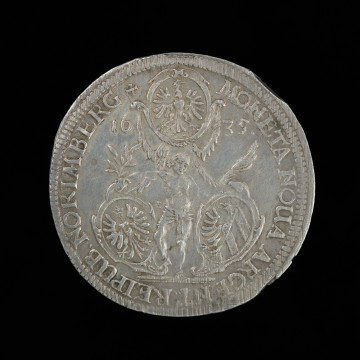
Thaler of the Reich
1624
National Museum in Szczecin
Part of the collection: German coins
In the early Middle Ages, Cologne was already the seat of an archbishopric, and by the late Middle Ages it had become a powerful city. In 1288 the burghers managed to get rid of the archbishop's power, but it was not until 1475 that Cologne was officially granted the status of an imperial city. Exercising its minting privilege, in the early 16th century the city made attempts to mint guilders. Small batches of heavy silver coins - thalers - took place in the second half of the 16th century. The production of thalers did not increase until the Thirty Years' War, when the municipal expenses increased. The presented coin comes from the second minting period of the Cologne thalers in the 16th century. It features the town's coat of arms, featuring strong religious symbolism. The escutcheon is covered by a helmet with a crest and mantling, which refers to the private heraldry of the archbishops and highlights the links of the city with the archbishopric. The escutcheon is divided into two fields. The first contains three crowns – commonly referred to as the crowns of the Three Kings, whose relics were brought to the city in 1164. The second field of the escutcheon is decorated with with a plant motif. The crest of the helmet is depicted in the form of a fan with ten small crowns, which is probably a reference to the legend of St. Ursula, the patron saint of Cologne. The escutcheon is held by supporters – a lion and a griffin. The form of the coat of arms described above was used on Cologne thalers until the mid-17th century. This design coincides with 16th-century iconographic sources, although the details are slightly different. The current coat of arms of Cologne strongly refers to the historical tradition. Gone are the supporters, and the escutcheon is now placed on the chest of the two-headed eagle of the Reich, to emphasize the city's former status and imperial protection. The field of the escutcheon, however, was reserved for the legend of St. Ursula, which was referenced by eleven flames.
Mieszko Pawłowski
Other names
Reichstaler
Author / creator
Dimensions
cały obiekt: diameter: 41.6 mm
Object type
coin, money
Technique
minting
Material
silver
Creation time / dating
Creation / finding place
Owner
National Museum in Szczecin
Identification number
Location / status

1624
National Museum in Szczecin

1623
National Museum in Szczecin

1559
National Museum in Szczecin
DISCOVER this TOPIC
Castle Museum in Łańcut
DISCOVER this PATH
Educational path